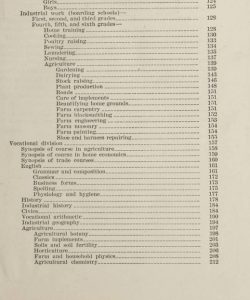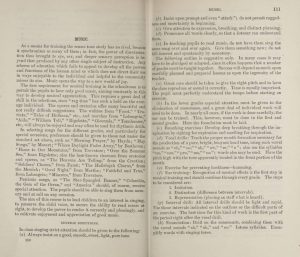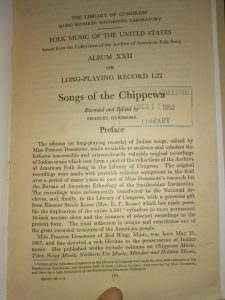It can be said that the worst outcomes come from the best of intentions. Of course, we look back in history and find that the definition of ‘best’ is thoroughly different between cultures, backgrounds, classes, races, etc. And obviously, if one were to take the extremely low-hanging fruit, it requires an impressive amount of logic leaps to find the ‘best intentions’ in some of the greatest historical tragedies, such as the Holocaust, any number of catastrophic wars, or the Trail of Tears.
While the history of Indian boarding schools is undoubtedly tragic, the discussion of the goals behind them is surprisingly frank and positive. As a report from a member of the Advisory Council on Indian Affairs to the Secretary of the Interior (one who had the fantastic decency to write his name in an illegible scrawl at the end of his letter to said Secretary of the Interior, at the time Hubert Work; I therefore have absolutely no idea who wrote thing beyond this) notes that the primary goal is to “place the American Indian… upon the same basis as the rest of our citizenship, politically, intellectually, and industrially…” with the disturbance of “community life or tribal or family relationships” no more “than a growing degree of general participation in economic and… political affairs has interfered with… the Negro…”1
Piercing through the incredible wordiness of this statement, it is perhaps difficult to gauge the true opinion of the report’s author. There is much wiggle-room presented in the goal, particular in the definition of an appropriate level of disturbance, but there does not seem to be explicit mention of disrupting family groups, of squashing heritage, and the like. Indeed, the report author notes that “the average American Indian should be educationally as well equipped and as self-reliant and self-sufficient as the average citizen of any other racial descent.”2 A noble goal, if not for the fact that the peoples in question had been self-reliant for well before the arrival of Europe in the New World.
Turning attention to the boarding schools established for the purposes of educating American Indians to the degrees mentioned above, analysis of their curriculum identifies that a significant amount of effort seems to have been put in to ensure a full coverage of all subjects, in science, history, math, and more. One example from the Office of Indian affairs, prepared for use throughout the Indian school service in 1915, dedicates 30 pages in its curriculum overview to Industrial work and over 130 pages to various vocational studies (trade, agriculture, home economics, nursing, etc)3.

A excerpt from the table of contents from curriculum proposed for American Indian students. Note the wide variety of topics available, especially relating to ‘practical’ work.
A section is, of course, dedicated to music. Although there is attention given to the coverage of ‘good’ music (which is something that many others have covered, I will therefore not beat a dead horse), interesting emphasis is placed on proper vocal techniques. Notes to have a “light, pure tone”, with special exercises for “preventing huskiness” and “the elimination of monotones” in the lower grade levels, perhaps were included specifically to ‘correct’ vocal styles that are used for Native American singing 4.

A excerpt from the table of contents from curriculum proposed for American Indian students. A guideline for vocal standards lays out what to prioritize while singing.
For example, in an analysis of different pow-wow singing styles, it is noted that the Great Lakes style uses a “medium-high voice, often with a gravelly or rough timbre” while in both the Great Lakes and Midplains style the women’s part is described as “high and tense”.5 These assertions are difficult to confirm, as during the early 20th century musical analysis of Native American styles was in its infancy, and unfortunately there is little literature that refers directly to behaviors or tendencies that need to be prevented (which would have been an obvious indicator of this type of connection), but the possibility of a link is still there.
In conclusion, this serves as a slightly different approach, as I was surprised to see that reports regarding Native Americans in the 20th century were not as overtly hostile as I might have suspected, going from history. This, of course, could entirely be fancy political language, and there is the additional factor of the majority not understanding the minority and wishing to impose upon them an idea of ‘correctness’, but I found it interesting regardless.
Works Cited:
1 Member of the Advisory Council on Indian Affairs, Report on Indian Affairs (United States Government, 1923), 1-2. Retrieved from American Indian Histories and Cultures https://www.aihc.amdigital.co.uk/Documents/Images/Ayer_MS_668/3#Chapters (accessed Oct 26, 2023).
2 Ibid
3 Department of the Interior (Office of Indian Affairs), Tentative Course of Study for United States Indian Schools (Washington D.C: Government Printing Office, 1915), Table of Contents. Retrieved from American Indian Histories and Cultures https://www.aihc.amdigital.co.uk/Documents/Images/Ayer_386_U5_1915/5 (accessed Oct 26, 2023).
4 Dept. of Interior, Tentative Course of Study, 111-113.
5 Tara Browner, Judith Vander, et al., Music of the First Nations: Tradition and Innovation in Native North America (University of Illinois Press: 2009), 137-138. Retrieved from https://ebookcentral.proquest.com/lib/stolaf-ebooks/reader.action?docID=3413835&ppg=147 (accessed on Oct 26, 2023).


